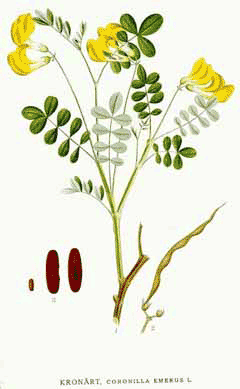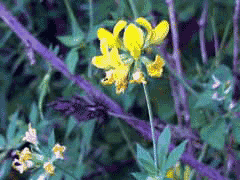 |
|
http://commons.wikimedia.org/wiki/File:323_Coronilla_emerus.jpg |
 |
|
Translate this page:
Summary
Physical Characteristics

 Coronilla emerus is an evergreen Shrub growing to 2.7 m (8ft 10in).
Coronilla emerus is an evergreen Shrub growing to 2.7 m (8ft 10in).
See above for USDA hardiness. It is hardy to UK zone 6. It is in leaf all year, in flower from May to October. The species is hermaphrodite (has both male and female organs) and is pollinated by Bees.
It can fix Nitrogen.
Suitable for: light (sandy) and medium (loamy) soils, prefers well-drained soil and can grow in nutritionally poor soil. Suitable pH: mildly acid, neutral and basic (mildly alkaline) soils. It cannot grow in the shade. It prefers dry or moist soil and can tolerate drought.
UK Hardiness Map
US Hardiness Map
Synonyms
Plant Habitats
Woodland Garden Sunny Edge;
Edible Uses
References More on Edible Uses
Medicinal Uses
Plants For A Future can not take any responsibility for any adverse effects from the use of plants. Always seek advice from a professional before using a plant medicinally.
Cardiac Diuretic
The plant is cardiac and diuretic[61].
References More on Medicinal Uses
The Bookshop: Edible Plant Books
Our Latest books on Perennial Plants For Food Forests and Permaculture Gardens in paperback or digital formats.

Edible Tropical Plants
Food Forest Plants for Hotter Conditions: 250+ Plants For Tropical Food Forests & Permaculture Gardens.
More

Edible Temperate Plants
Plants for Your Food Forest: 500 Plants for Temperate Food Forests & Permaculture Gardens.
More

More Books
PFAF have eight books available in paperback and digital formats. Browse the shop for more information.
Shop Now
Other Uses
References More on Other Uses
Cultivation details
Succeeds in a sunny position in most well-drained soils[184], preferring a moderately rich loamy soil[11, 182, 200]. An easily grown plant[11], it is hardy to about -20°c[184] if it is sheltered from cold winds[200]. Plants can be pruned almost back to the base if required, they usually resprout freely[200]. The flowers are sweetly scented[245]. This species has a symbiotic relationship with certain soil bacteria, these bacteria form nodules on the roots and fix atmospheric nitrogen. Some of this nitrogen is utilized by the growing plant but some can also be used by other plants growing nearby[200]. Plants in this genus are notably resistant to honey fungus[200].
References Carbon Farming Information and Carbon Sequestration Information
Temperature Converter
Type a value in the Celsius field to convert the value to Fahrenheit:
Fahrenheit:
The PFAF Bookshop
Plants For A Future have a number of books available in paperback and digital form. Book titles include Edible Plants, Edible Perennials, Edible Trees,Edible Shrubs, Woodland Gardening, and Temperate Food Forest Plants. Our new book is Food Forest Plants For Hotter Conditions (Tropical and Sub-Tropical).
Shop Now
Plant Propagation
Seed - scarify and then pre-soak the seed for 1 - 2 hours in warm water[164]. A period of cold stratification is also said to be helpful[200]. Sow the seed in spring in a greenhouse. Germination usually takes place in 4 - 6 weeks at 15°c[164]. Pot up the seedlings as soon as possible into individual pots and plant them out in the following spring[164]. Cuttings of greenwood, June in a frame with bottom heat[11]. Cuttings of half-ripe wood, July/August in a frame[11]. Cuttings of nearly mature side shoots, firm at the base and 7 - 10cm long with a heel, October/November in a frame. Plants are well rooted after 12 months. Good percentage[78].
Other Names
If available other names are mentioned here
Native Range
EUROPE: Norway (south), Sweden (south), Czechoslovakia, Austria, Switzerland, Germany, Hungary, Former Yugoslavia, Italy (incl. Sardinia, Sicily), Spain (east), France (incl. Corsica)
Weed Potential
Right plant wrong place. We are currently updating this section.
Please note that a plant may be invasive in one area but may not in your area so it's worth checking.
Conservation Status
IUCN Red List of Threatened Plants Status :

Growth: S = slow M = medium F = fast. Soil: L = light (sandy) M = medium H = heavy (clay). pH: A = acid N = neutral B = basic (alkaline). Shade: F = full shade S = semi-shade N = no shade. Moisture: D = dry M = Moist We = wet Wa = water.
Now available:
Food Forest Plants for Mediterranean Conditions
350+ Perennial Plants For Mediterranean and Drier Food Forests and Permaculture Gardens.
[Paperback and eBook]
This is the third in Plants For A Future's series of plant guides for food forests tailored to
specific climate zones. Following volumes on temperate and tropical ecosystems, this book focuses
on species suited to Mediterranean conditions—regions with hot, dry summers and cool, wet winters,
often facing the added challenge of climate change.
Read More
Expert comment
Author
L.
Botanical References
1150200
Links / References
For a list of references used on this page please go here
Readers comment
© 2010, Plants For A Future. Plants For A Future is a charitable company limited by guarantee, registered in England and Wales. Charity No. 1057719, Company No. 3204567.